ASANAS
Please note: this content is posted for students in our corporate classes as a reference. If you're new to Yoga, please engage a qualified teacher or yoga centre to guide you. Practise yoga by reading books or watching videos could be dangerous and misguided. Adideva
Asana means “a position in which one feels comfortable". Asanas are a kind of exercise by which, through regular practice, the body stays healthy, hardy and many diseases are cured. They are also known as yoga postures. The relation between the physical body and the mind is very close. Mental expression is brought about through the vrttis (propensities of mind, eg, anger, fear, shame). The predominance of the vrttis depends on the different glands in the body. There are many glands in the body, each of which secretes particular hormones. If there is any defect in the secretion of hormones or any defect in a gland, certain vrttis become excited. If a person wants to control these excited propensities, s/he must rectify the defects of the glands. Asanas help greatly in this task.
Rules of Asanas
The following are some guidelines which should be followed when doing asanas. Asanas are a very subtle, yet very potent, practice which affects all three levels - physical, mental and spiritual - of your being. Asanas should only be done under the guidance of a qualified teacher.
- Half-bath or a full bath should be taken before doing asanas, unless you are practicing them right after meditation.
- Asanas should not be done outdoors but in a ventilated room.
- There should be no incense smoke or other smoke in the room.
- Tight fitting underwear should be worn while doing asanas; if possible, no other clothing should be worn.
- Practice asanas on a blanket or mat.
- Practice asanas only while the breath is flowing through the left nostril or both nostrils.
- A sentient vegetarian diet is preferable.
- Wait 2½ - 3 hours after a heavy meal before doing asanas. After asanas, wait about 10 mins before eating or drinking.
9. After asanas,
a. massage the whole body especially the joints very well;
b. remain in corpse posture for 2-10 minutes;
c. do not touch water for at least 10 minutes;
10. Sports or other exercises should not be done immediately after asanas.
11. If sick, don't practice asanas.
12. Women should not practise asanas during menstruation; asanas may be practised in the early months of pregnancy under the guidance of a qualified teacher.
YOGAMUDRA - YOGASANA
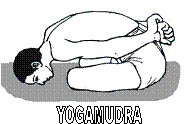 Sit with legs crossed.
Sit with legs crossed.
Grasp left wrist with right hand behind back.
Then bring forehead and nose in contact with the floor,
breathing out during the process.
Maintain this state for 8 seconds
and then rise, breathing in.
Practise 8 times.
This is one of the three essential asanas for women.
It should be practised by women everyday.
Benefits: Strengthens digestive system,
relieves constipation,
helps with menstrual problems,
strengthens heart,
and removes belly-fat.
BHUJAUNGASANA - COBRA POSTURE
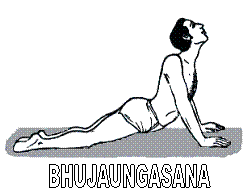 Lie down on your chest.
Lie down on your chest.
Supporting the weight on the palm,
raise the chest, directing your head backward.
Look at the ceiling.
Breathe in while rising and after having risen,
hold your breath for 8 seconds.
Come down to the original position while breathing out.
Practise 8 times.
This is one of the three essential asanas for women.
It should be practised by women everyday.
Benefits: Helps with menstrual problems,
strengthens spine, heart,
lungs & abdomen.
DIIRGHA PRANAMA - LONG SALUTATION POSTURE
Kneel and, holding the palms together,
extend the arms upwards,
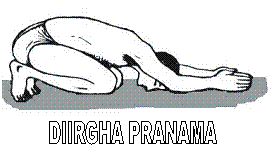 keeping them close to the ears.
keeping them close to the ears.
Then bend forwards touching the floor
with the nose and forehead.
The buttocks must continue to touch the heels.
While bending down, breathe out and
stay in a state of complete exhalation for 8 seconds.
Then rise, breathing in.
Practise 8 times.
This is one of the three essential asanas for women.
It should be practised by women everyday.
Benefits: helps in menstrual troubles;
strengthens stomach, abdomen
and lower back muscles;
good for spine.
JANUSHIRASANA - HEAD TO KNEE POSTURE
Press the muladhara cakra with the right heel.
Women should not press the muladhara but place the heel
slightly to the side under the buttock. Extend the left leg forward.
While exhaling, touch the left knee with the forehead.
Then, interlocking all the fingers firmly, press the left sole with the hands.
There should be complete expiration when the forehead touches the knee:
 Maintain this position for 8 seconds.
Maintain this position for 8 seconds.
Separate hands and sit erect while breathing in.
Then press the muladhara or its side (for women)
with the left heel and repeat the above process.
This constitutes one round.
Practise 4 rounds.
Benefits: Good for stomach and piles
and for feelings of hopelessness.

UTKSEPA MUDRA
As soon as you wake up in the morning, while still in bed, inhale deeply and flex both your legs,
pressing them tightly against your chest with your arms. Then vigorously extend the legs, exhaling completely. Repeat 6-8 times. Then rise and drink a glass of water.
Drink the water without letting it touch the teeth (a straw may be used) as the mouth has not been cleaned. After this, uncover the navel area, exposing it to the air to cool it.
Then walk around for a few minutes.
Benefits: strengthens digestive system;
relieves constipation.
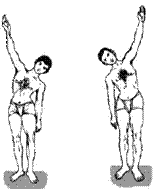


![]()
PADAHASTASANA - ARM AND LEG POSTURE
Stand erect, raising the arms, palms open. Then bend the trunk and the left arm leftwards while breathing out and, in a state of full expiration, touch the side of the left leg with the left hand. After maintaining this position for 8 seconds, raise the body and extend the left arm upwards, breathing in throughout the process. When the body is perfectly erect again, bend the trunk and the right arm rightwards, breathing out and, in a state of full expiration, hold for 8 seconds, touching the side of the right leg with the right hand. Then raise the trunk, extending the arm upwards, inhaling throughout the process. Then bend the trunk forward, breathing out in the process, and catch hold of the big toes. Stay in this position for 8 seconds. Then rise while breathing in, raise the arms and extend them backwards. When you cannot bend back any further, hold yourself in that position for 8 seconds while retaining your breath. Then bend forward while breathing out to touch the big toes and immediately after raise the trunk and arms, breathing in. One round is then complete. Practise 8 rounds, making sure that no part of the body below the waist is bent at any time.
Benefits: stimulates the top five cakras (psychic centres);
energises the body.
GOMUKHASANA - COW'S HEAD POSTURE
Sit down and extend the legs forwards.
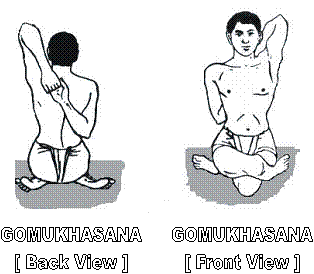 Bring the right leg under the left thigh,
Bring the right leg under the left thigh,
placing the right foot under the left buttock.
Now bring the left leg across the right thigh
and place the left foot under the right buttock.
Place the left hand on the spine.
Then bring the right hand backward
over the right shoulder and interlock the fingers
of the hands in a chain-like fashion, practice
in the same way with the left leg under the right leg.
Completing this on both sides constitutes one round.
Duration of each position - half a minute.
Practise 4 rounds.
Benefits: controls unwanted thoughts;
good for piles and kidney problems.
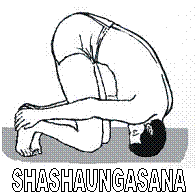 SHASHAUNGASANA - HARE POSTURE
SHASHAUNGASANA - HARE POSTURE
Kneel down and grasp both the heels firmly.
While exhaling, bring the crown of the head
into contact with the floor in a posture of bowing down.
The forehead should touch the knees.
Maintain this posture for 8 seconds, holding the breath.
Breathe in while rising.
Practise 8 times.
Benefits: improves memory and concentration;
good for meditation;
helps in throat and thyroid problems;
reduces belly fat.
SAHAJAUTKATASANA - SIMPLE CHAIR POSTURE
Seat yourself as if in a chair.
Keep arms straight as if on the arms of the chair.
Hold for 30 seconds.
Practise 4 times.
Benefits: good for balance and knees.
GARUDASANA - BIRD POSTURE
Stand erect. Stretch right leg as far back as possible.
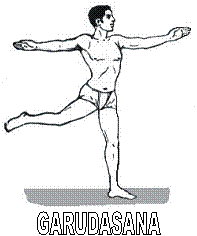 Extend left arm forward and right arm backward,
Extend left arm forward and right arm backward,
keeping both arms parallel to the ground.
Reach out the right hand towards the right big toe,
as if to touch it. Do not bend the body at all
but the right leg may be bent slightly upwards.
Hold for 30 seconds.
Repeat this process with left leg stretched backward.
This completes one round. Practice 4 rounds.
Benefits: develops perfect balance;
strengthens nerves in arms and legs;
reduces body weight.
SYSTEM FOR HOME PRACTICE
- Do a short warm up.
- Practice about 4 Asanas (max 6), twice daily
(Preferably before breakfast and before dinner),
do a short corpse posture in between two different sets of Asanas.
- Kaoshikii.
- Massage.
- Do minimum two minutes of corpse posture.
- Meditation.
TULADANDASANA - BALANCE POSTURE
Standing on the left foot,
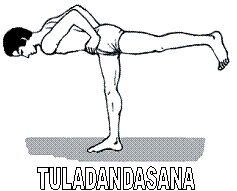 direct the other foot backward and raise it.
direct the other foot backward and raise it.
Grasp waist on both sides with hands
and then bend the trunk and head forward
such that the head, trunk and
extended leg are parallel to the floor.
Hold for 30 seconds.
Repeat the process standing on the right foot.
This constitutes one round.
Practise 4 rounds.
Benefits: Strengthens nerves,
especially in the legs;
develops balance.
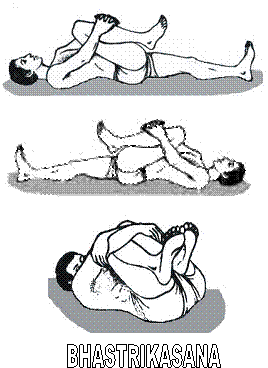
BHASTRIKASANA - BELLOWS POSTURE
Lie on your back and, while breathing out,
bend the right leg and bring the thigh
into contact with the chest.
Grasp the leg firmly with both hands.
Maintain this position for 8 seconds,
holding the breath.
Resume original position while breathing in.
Practise similarly with the left leg
and then with both legs together.
This comprises one round. Practise 8 rounds.
Benefits: strengthens digestive system;
relieves constipation;
removes gas and belly fat.
KARMASANA - ACTION POSTURE
This asana is made up of two parts. The second part complements the first.
Performance of both parts makes one round. 4 rounds should be practised.
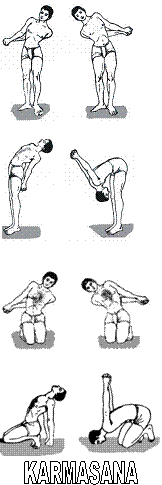
Part I - Stand upright and, placing both hands behind the back,
interlock fingers and press palms together. Keeping the body
below the navel steady, move the upper body in four directions
as in Padahastasana. Bend the upper part of the body leftwards,
breathing out, and stay in this position for 8 seconds,
holding the breath. Resume original position, breathing in.
Move interlocked hands to the right when the body bends leftwards.
Remember that the left arm should touch the back
when the body is bent and keep touching it while holding this position.
Practise similarly on the other side – bend the upper part of the body to the right
and move interlocked hands to the left. Bend downward exhaling slowly.
As you bend lower and lower, gradually raise interlocked hands upwards.
Bring the head as low as possible and raise the arms upwards
with the hands interlocked. Do not bend knees.
Hold this position for 8 seconds without inhaling. Resume original position, inhaling.
Bend the upper part of the body backwards while inhaling.
While bending trunk, head and neck backwards, hold interlocked hands straight down.
Stay in this position, holding the breath, for 8 seconds.
Breathing out, resume original position.
Part 11 - Kneel and sit on the heels.
Repeat Part I, moving the body in all four directions.
The toes should point forwards.
Remember not to bend the body below the navel.
While bending forwards, the nose and fore head
should touch the ground. While bending backwards,
the interlocked hands should graze the soles of the feet
and touch the ground, supporting the weight a little.
Benefits: stimulates the lower five cakras, internal organs;
And energises the body.
USTRASANA - CAMEL POSTURE
Lie in a supine position with arms touching the sides of the body. Raise both legs together from the floor to form an angle of 30 degrees, (about 12” off the floor) Hold for 30 seconds. Practice 4 times.
Benefits: strengthens the lower three cakras and abdomen.

![]()
DHANURASANA - BOW POSTURE
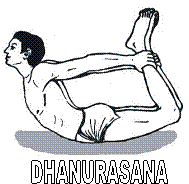 Lie in a prone position. Flex the legs to bring the lower legs close to the thighs. Directing the hands over the back, grasp the ankles. While breathing in, raise the entire body, supporting the weight on the navel. Extend the neck and chest as far back as possible. Look towards the front. Hold the breath and position for 8 seconds. Return to prone position while breathing out. Practise 8 times.
Lie in a prone position. Flex the legs to bring the lower legs close to the thighs. Directing the hands over the back, grasp the ankles. While breathing in, raise the entire body, supporting the weight on the navel. Extend the neck and chest as far back as possible. Look towards the front. Hold the breath and position for 8 seconds. Return to prone position while breathing out. Practise 8 times.
Benefits: strengthens throat, abdomen,
arms and legs.
UTKATA PASCHIMOTTANASANA: FULL HEAD TO KNEE POSTURE
Lie in a supine position an extend the arms backwards, keeping them close to the ears Rise while exhaling and insert the face between the knees. Make sure that the legs remain straight Grasp both the big toes with the hands remain in his state for eight seconds. Now resume the original posture while inhaling. Practice eight times in this way.
Benefits: Removes excess belly fat and improves the appetite.
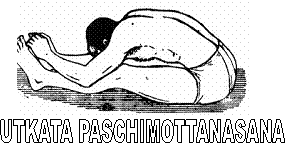
Ask a question:
Nutrimax Wellness Store, Singapore
390 Victoria St #02-30 Golden Landmark (Opp. Raffles Hospital) Singapore 188061 Tel: 6292 2991, 83338375 (Mobile)


